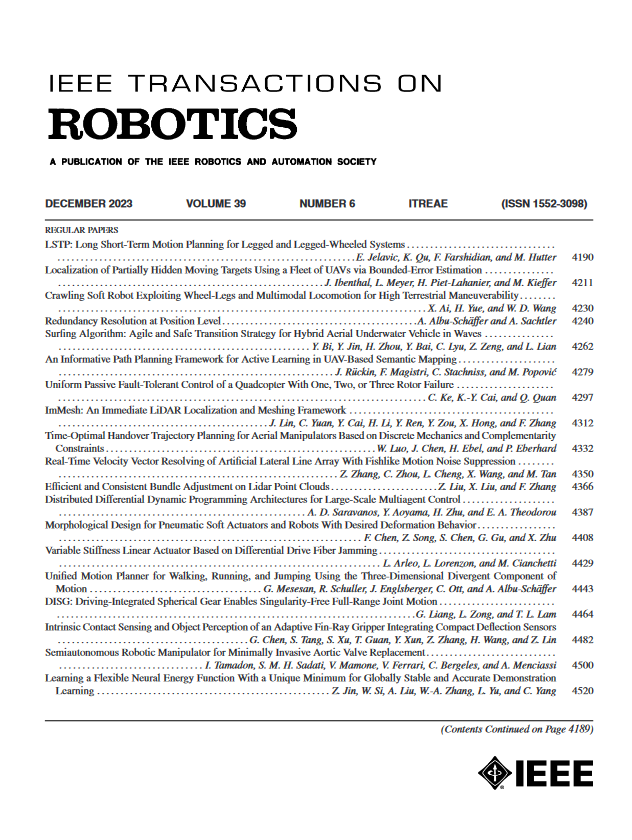推进器辅助水下六足机器人的稳定性标准和稳定性增强方法
IF 9.4
1区 计算机科学
Q1 ROBOTICS
引用次数: 0
摘要
稳定性准则是腿式机器人运动规划和控制算法设计的关键。如果这些算法在理论上不能保证有腿机器人的稳定性,我们需要多次试验来确定合适的稳定运动参数。然而,大多数现有的稳定性标准都是针对完全由腿驱动的机器人量身定制的,而不能应用于推进器辅助的有腿机器人。本文提出了一种由推进器辅助的水下六足机器人的稳定性判据,通过求出最大和最小允许推力,并将其与当前推力进行比较,以检验其稳定性。在此基础上,提出了一种通过调整推力值来增加机器人稳定裕度的方法。这个过程被称为稳定性增强。该准则采用优化方法,将机器人本体的姿态、速度、加速度、腿部关节的角度和角速度等多个变量转化为一个变量(推力),直接判断机器人的稳定性。此外,稳定性增强方法简单易行,因为它只需要调整推力。这些提供了对诸如惯性力、流体力、推力、重力和浮力等多类力如何影响机器人稳定性的见解。本文章由计算机程序翻译,如有差异,请以英文原文为准。
Stability Criterion and Stability Enhancement for a Thruster-Assisted Underwater Hexapod Robot
The stability criterion is critical for the design of legged robots' motion planning and control algorithms. If these algorithms cannot theoretically ensure legged robots' stability, we need many trials to identify suitable parameters for stable locomotion. However, most existing stability criteria are tailored to robots driven solely by legs and cannot be applied to thruster-assisted legged robots. Here, we propose a stability criterion for a thruster-assisted underwater hexapod robot by finding maximum and minimum allowable thruster forces and comparing them with the current thrusts to check its stability. On this basis, we propose a method to increase the robot's stability margin by adjusting the value of thrusts. This process is called stability enhancement. The criterion uses the optimization method to transform multiple variables such as attitude, velocity, acceleration of the robot body, and the angle and angular velocity of leg joints into one kind of variable (thrust) to judge the stability directly. In addition, the stability enhancement method is straightforward to implement because it only needs to adjust the thrusts. These provide insights into how multiclass forces such as inertia force, fluid force, thrust, gravity, and buoyancy affect the robot's stability.
求助全文
通过发布文献求助,成功后即可免费获取论文全文。
去求助
来源期刊

IEEE Transactions on Robotics
工程技术-机器人学
CiteScore
14.90
自引率
5.10%
发文量
259
审稿时长
6.0 months
期刊介绍:
The IEEE Transactions on Robotics (T-RO) is dedicated to publishing fundamental papers covering all facets of robotics, drawing on interdisciplinary approaches from computer science, control systems, electrical engineering, mathematics, mechanical engineering, and beyond. From industrial applications to service and personal assistants, surgical operations to space, underwater, and remote exploration, robots and intelligent machines play pivotal roles across various domains, including entertainment, safety, search and rescue, military applications, agriculture, and intelligent vehicles.
Special emphasis is placed on intelligent machines and systems designed for unstructured environments, where a significant portion of the environment remains unknown and beyond direct sensing or control.
 求助内容:
求助内容: 应助结果提醒方式:
应助结果提醒方式:


